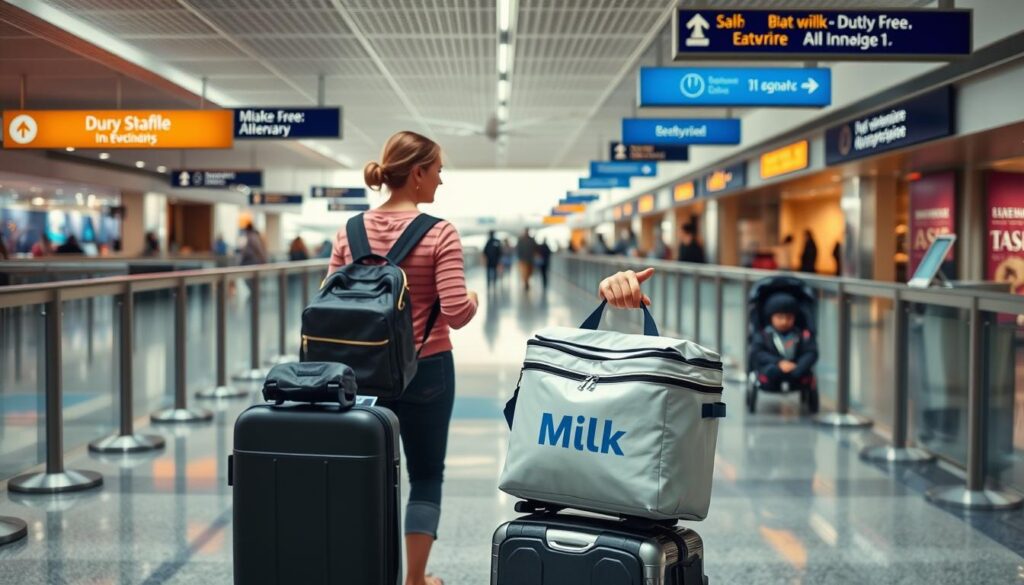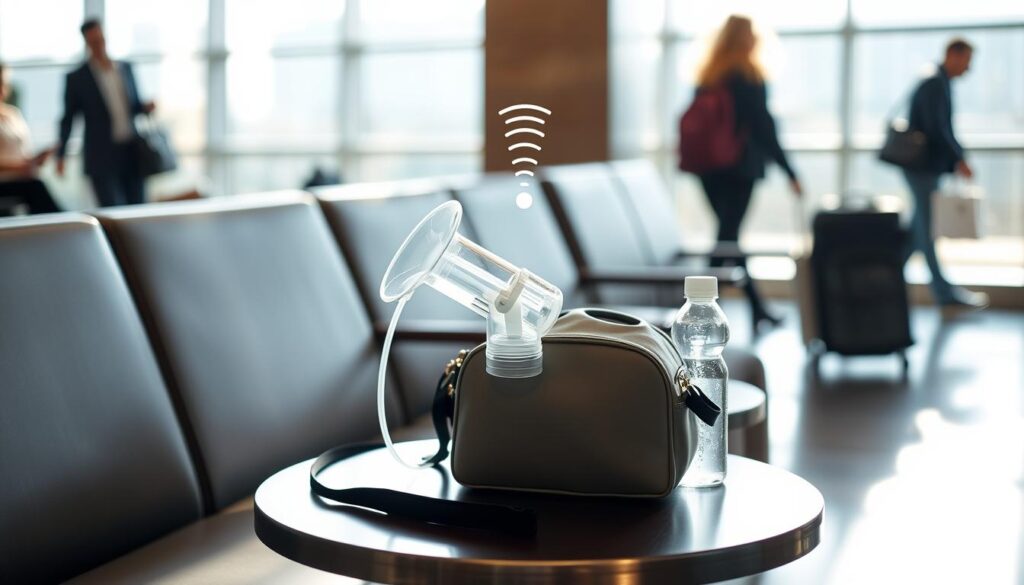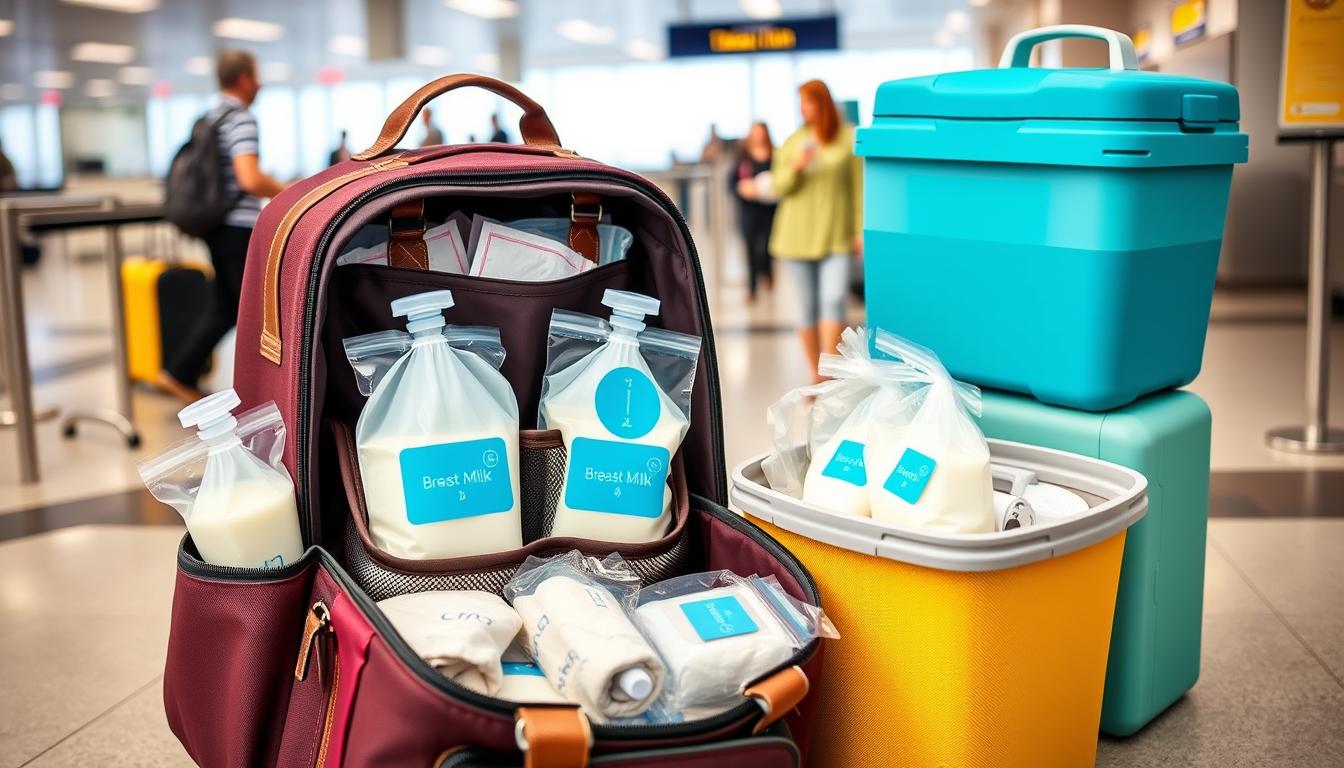Traveling with breast milk can be tough for nursing moms. It doesn’t matter if you’re going on a short trip or a big vacation. Knowing how to pack breast milk is key.
This guide will give you tips on TSA rules, how to store it, and keeping up your milk supply while traveling.
We’ll talk about packing the right stuff and understanding security rules. You’ll learn how to keep your milk safe and easy to carry. Our advice will make you feel ready for your trip. It will help your baby get the best nutrition, even when you’re not there.
Key Takeaways
- Familiarize yourself with TSA regulations for breast milk
- Invest in quality storage equipment for safe transport
- Learn proper temperature management techniques
- Develop efficient pumping strategies for travel
- Understand international travel considerations
- Prepare for air travel challenges
- Maintain your milk supply while away from home
Understanding TSA Rules and Regulations for Breast Milk
Traveling with breast milk can be tough. But, knowing TSA rules makes it easier. Airport security has rules to keep you safe and help nursing moms.
Current TSA Liquid Guidelines Exceptions
Breast milk doesn’t follow the 3-1-1 liquid rule. You can carry more than 3.4 ounces in your bag. This rule also applies to formula and juice for little ones.
Documentation Requirements for Traveling with Breast Milk
While not needed, a doctor’s note or your child’s birth certificate can help. These papers show why you need to carry breast milk, like on long trips or without your baby.
Security Screening Procedures for Breast Milk
TSA agents might check your breast milk. They might ask you to open it or move some to a new container for testing. You can choose not to have it X-rayed and ask for other ways to check it.
| Item | Carry-on | Checked Bag |
|---|---|---|
| Breast Milk | Allowed in reasonable quantities | Allowed |
| Ice Packs | Allowed for breast milk | Allowed |
| Pump and Parts | Allowed | Allowed |
Even eco-conscious travelers can pack breast milk sustainably. Use reusable containers and coolers to reduce waste on your trip.
“Our officers are well versed in the procedures for screening breast milk and will treat it with respect and professionalism.” – TSA Official Statement
Essential Equipment for Breast Milk Storage During Travel
Traveling with breast milk needs careful planning and the right gear. Moms must have reliable equipment to keep their milk safe and fresh. Let’s look at the must-have items for your trip.
Best Breast Milk Cooler Bags for Travel
Breast milk cooler bags are key for keeping milk at the right temperature. Look for ones that are well-insulated and have many compartments. The PackIt Freezable Breast Milk Cooler and the Medela Breast Milk Cooler Set are great choices.
Reliable Ice Packs and Cooling Solutions
Use high-quality breast milk ice packs with your cooler bag. Contoured ice packs fit well around milk bottles, cooling them better. The Flexi Freeze Ice Sheets are a favorite, cooling for a long time.
Storage Containers and Bags Recommendations
For safe storage, use BPA-free containers or pre-sterilized bags. Lansinoh Breastmilk Storage Bags are strong and have a double zipper seal. Glass bottles like the Philips Avent Natural Glass Baby Bottles are good for the planet and easy to clean.
| Item | Features | Recommended Brand |
|---|---|---|
| Cooler Bag | Insulated, Multiple Compartments | PackIt Freezable |
| Ice Packs | Contoured, Long-lasting | Flexi Freeze Ice Sheets |
| Storage Bags | Pre-sterilized, Double Zipper | Lansinoh Breastmilk Storage Bags |
| Bottles | BPA-free, Easy to Clean | Philips Avent Natural Glass |
How to Travel with Breast Milk on Different Transportation
Traveling with breast milk can be hard, no matter the transport. Whether flying or driving, planning is crucial. This keeps your milk safe and fresh.
Air travel needs the most prep. Tell TSA you have breast milk. They’ll check it apart from other liquids. Use clear, sealed containers and an insulated cooler with ice packs.
Driving? A good cooler is a must. Use ice packs or gel packs for the right temperature. For long trips, stop for ice at restaurants or rest stops.
Trains offer more freedom. Bring a small cooler and ask for ice from the dining car. On boats, tell the crew about your milk. They might store it in a fridge for you.
| Transport Mode | Storage Method | Temperature Control |
|---|---|---|
| Airplane | Insulated cooler | Ice packs |
| Car | Large cooler | Ice or frozen gel packs |
| Train | Small cooler | Ice from dining car |
| Boat | Cooler or ship’s refrigerator | Ice packs or refrigeration |
Always keep your breast milk at the right temperature, no matter how you travel. With the right planning, you can transport your milk safely and follow the guidelines.
Proper Temperature Management and Storage Times
When traveling, keeping breast milk at the right temperature is key. This ensures it stays safe and good for your baby.
Safe Temperature Ranges for Breast Milk
Breast milk can be stored safely in different ways. Fresh breast milk can sit at room temperature for 4 hours. It can last up to 24 hours in a cooler with ice packs. In the fridge, it stays good for 4 days.
Maximum Storage Duration Guidelines
Here are the best times to store breast milk:
| Storage Method | Temperature | Maximum Duration |
|---|---|---|
| Room temperature | 77°F (25°C) or colder | Up to 4 hours |
| Insulated cooler | 59°F (15°C) | Up to 24 hours |
| Refrigerator | 40°F (4°C) or colder | Up to 4 days |
| Freezer | 0°F (-18°C) or colder | Up to 6 months |
Monitoring Methods During Travel
Here’s how to keep breast milk safe while traveling:
- Pack a portable thermometer to check milk temperature
- Use insulated coolers with ice packs for short trips
- Label containers with date and time of expression
- Avoid opening cooler frequently to maintain temperature
By following these tips, you can keep your breast milk safe and good for your baby during travel.
Pumping Strategies While Traveling
Traveling doesn’t stop you from pumping milk. You can keep pumping and feeding your baby. Here are some tips to help you pump while traveling.
Finding good places to pump is important. Look for nursing rooms in airports or malls. If you can’t find one, a clean bathroom or your car will do. Always choose a private and comfy spot.
Keeping clean is a must. Bring wipes and sanitizer to clean your hands and pump parts. Also, pack extra parts like tubing or valves for emergencies.
Using your pump wisely saves time and stress. Get a travel pump that’s light and small. Some moms like manual pumps because they’re easy to carry.
| Essential Breast Milk Pump Accessories | Purpose |
|---|---|
| Microwave sterilizer bags | Quick sterilization of pump parts |
| Battery pack or power bank | Ensures pump power on-the-go |
| Hands-free pumping bra | Allows multitasking while pumping |
| Cooler bag with ice packs | Keeps milk fresh during travel |
Being consistent is important. Try to pump at the same times as you usually do. If you’re traveling across time zones, adjust your pumping times slowly.
International Travel Considerations for Breast Milk
When flying with breast milk internationally, moms face unique challenges. Breast milk travel guidelines vary across borders, making preparation crucial. Understanding country-specific regulations, customs requirements, and voltage differences for pump equipment ensures a smoother journey.
Country-Specific Regulations
Different nations have distinct rules for transporting breast milk. Some countries limit quantities, while others require specific documentation. Research your destination’s policies before departure. Contact the embassy or consulate for the most current information on flying with breast milk.
Customs Declaration Requirements
Declare breast milk at customs to avoid issues. Many countries allow breast milk entry without restrictions, but some may require inspection. Carry a doctor’s note or your baby’s birth certificate to verify the milk’s purpose. Be prepared to explain your breast milk storage methods if asked.

Voltage Differences for Pump Equipment
Electric breast pumps may not work abroad due to voltage differences. Check your pump’s compatibility with international power sources. Consider these options:
- Use a manual pump as a backup
- Invest in a battery-operated pump
- Bring a voltage converter for your electric pump
By addressing these international travel considerations, moms can confidently transport breast milk across borders. Remember to stay flexible and patient throughout your journey.
Tips for Air Travel with Breast Milk
Flying with breast milk needs careful planning. Here are some tips to help you travel smoothly. These tips cover airport security and your flight.
Pre-Flight Preparation Steps
Pack your breast milk in clear, sealed containers before you go. Use insulated cooler bags with ice packs to keep it cold. Tell the TSA officer you have breast milk to speed up the check.
During Flight Management
Make sure your breast milk cooler is easy to reach during the flight. If it gets too warm, ask the flight attendant for ice. Some airlines have special services for keeping milk cold, so check ahead of time.
Dealing with Flight Delays
Flight delays can be tough when you have breast milk. Pack extra ice packs and storage bags for long waits. If you’re stuck for a while, ask airport staff about cold storage or places to buy more ice.
- Bring a portable breast pump for extended delays
- Know your rights regarding pumping areas in airports
- Label your milk containers with the date and time expressed
Follow these tips to handle airport security and keep your milk safe on your trip.
Common Challenges and Solutions
Traveling with breast milk can be tricky. Let’s look at some common problems and how to solve them. This way, you can keep your milk safe while on the move.
Milk spills are a big worry. Use containers that won’t leak and wrap your milk in extra bags. Always have extra bags ready. If you spill, clean it up fast and ask for ice to keep the milk cold.
Equipment problems can stop you from pumping. Carry parts for a manual pump as a backup. For electric pumps, bring extra batteries or a charger. Knowing how to express milk by hand is also helpful.
Travel plans can change unexpectedly. Always pack more than you think you’ll need. Bring a small cooler with ice packs for quick storage. Look into shipping milk to your destination if you’re delayed.
| Challenge | Solution |
|---|---|
| Milk spillage | Use leak-proof containers, double-bag milk |
| Equipment malfunction | Bring manual pump parts, spare batteries |
| Travel changes | Pack extra supplies, carry small cooler |
| Security screening issues | Know TSA rules, communicate with agents |
Traveling with breast milk needs planning and being ready for anything. By thinking ahead, you can deal with any problem that comes up on your trip.
Maintaining Milk Supply During Travel
Traveling can change your routine, but it doesn’t have to hurt your milk supply. With smart strategies, you can pump milk on the go easily and well.
Pumping Schedule Management
Keep your pumping schedule the same as you can. Use your phone to remind you to pump every 2-3 hours. If you’re going across time zones, slowly change your schedule to fit the new time.

Hydration and Nutrition Tips
Drink water all day to stay hydrated. Bring healthy snacks like nuts, fruits, and granola bars. They give you the energy and nutrients you need to keep pumping milk.
Stress Management Techniques
Travel can be stressful, which might lower your milk. Try deep breathing or listen to calm music while pumping. Carry a photo of your baby to help you pump better when you’re not at home.
- Find a quiet, comfy spot to pump when you can
- Use a hands-free pumping bra for easy pumping
- Think about a portable, battery pump for more freedom
Being consistent is important when pumping milk on the go. With good planning and taking care of yourself, you can keep your milk supply up, even when you’re traveling a lot.
Conclusion
Traveling with breast milk is easier than you think. Learn about breast milk travel guidelines to plan your trip well. You’ll know how to keep your baby fed.
Start by understanding TSA rules. Pack the right stuff and keep milk at the right temperature. This makes traveling smooth.
Being prepared is important. Get good cooler bags, ice packs, and containers. Plan for delays and have a pumping plan ready.
For trips abroad, check local rules and customs. This helps avoid any issues.
With these tips, traveling becomes easier. Breastfeeding moms can now travel with confidence. They know they can feed their babies anywhere.


